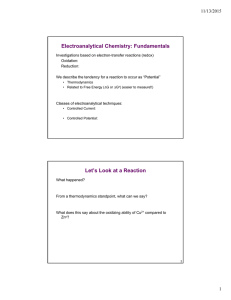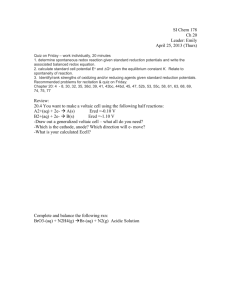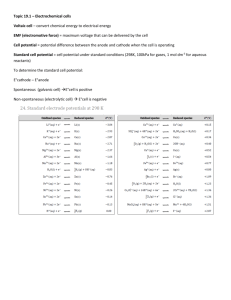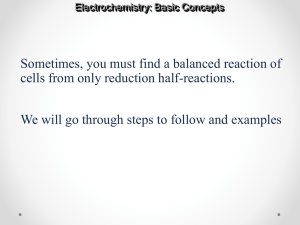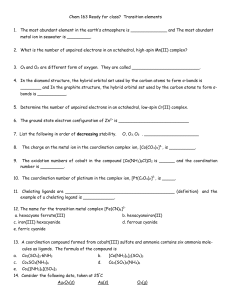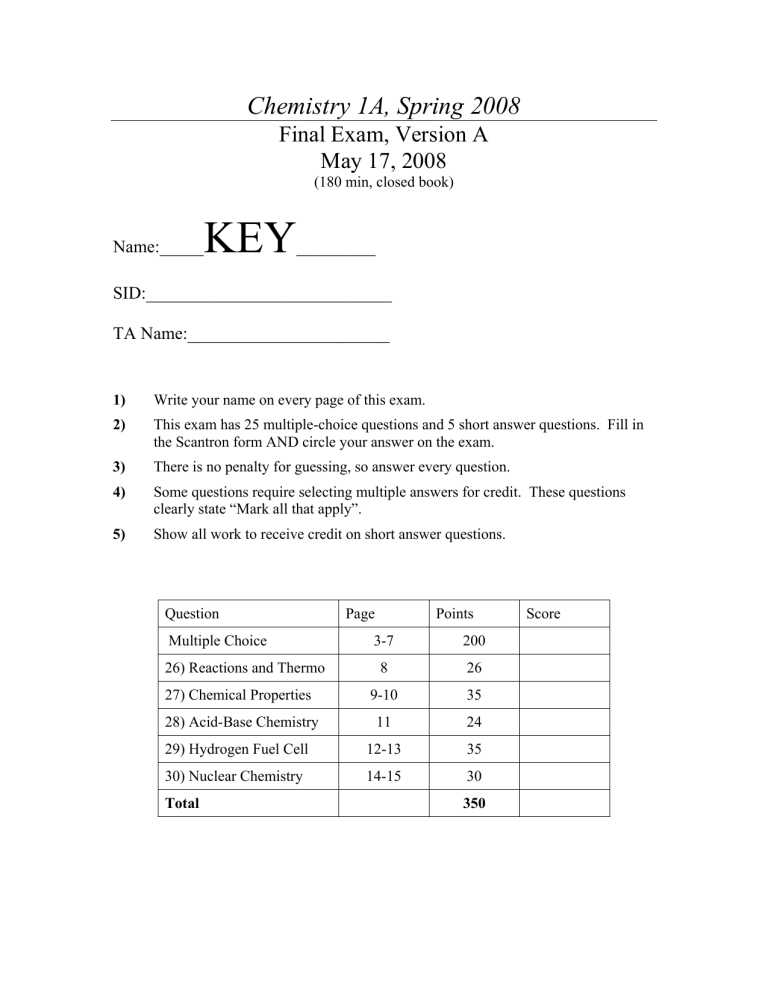
Chemistry 1A, Spring 2008 Final Exam, Version A May 17, 2008 (180 min, closed book) Name:_____ KEY _________ SID:____________________________ TA Name:_______________________ 1) Write your name on every page of this exam. 2) This exam has 25 multiple-choice questions and 5 short answer questions. Fill in the Scantron form AND circle your answer on the exam. 3) There is no penalty for guessing, so answer every question. 4) Some questions require selecting multiple answers for credit. These questions clearly state “Mark all that apply”. 5) Show all work to receive credit on short answer questions. Question Multiple Choice Page Points 3-7 200 8 26 27) Chemical Properties 9-10 35 28) Acid-Base Chemistry 11 24 29) Hydrogen Fuel Cell 12-13 35 30) Nuclear Chemistry 14-15 30 26) Reactions and Thermo Total 350 Score E = mc2 E = hν λν = c λ deBroglie = h / p = h / mv Ekin (e-) = hν - Φ = hν - hν 0 Z2 E n = − 2 R∞ n ⎛1 1⎞ E i→ f = −R∞ ⎜⎜ 2 − 2 ⎟⎟ ⎝ n f ni ⎠ ∆x ∆p ≥ h/4π p = mv PV = constant PV = nRT 3 E kin = RT 2 3RT v rms = M ∆E = q + w w = - Pext∆V 3 ∆E = nR∆T 2 N0 = 6.02214 x 1023 mol-1 R∞ = 2.179874 x 10-18 J R∞ = 3.28984 x 1015 Hz Color and Wavelength of Light Wavelength (nm) 400 600 800 IR Red Green Blue me = 9.101939 x 10-31 kg c = 2.99792 x 108 m s-1 Gas Constant: R = 8.31451 J K-1 mol-1 R = 8.20578 x 10-2 L atm K-1 mol-1 T (K) = T (C) + 273.15 F = 96,485 C / mol 1V=1J/C 1 nm = 10-9 m 1 kJ = 1000 J 1 J = kg m2 s-2 1 atm = 760 mmHg = 101,325 Pa 1 atm L = 101.3 J UV ∆G° = ∆H° - T∆S° ∆H° = Σ ∆H°f (products) - Σ ∆H°f (reactants) ∆S° = Σ S° (products) - Σ S° (reactants) ∆G° = Σ ∆G°f (products) - Σ ∆G°f (reactants) S = kBlnW ∆G° = - RTln K ∆H ° 1 ∆S ° ln K = − + R T R ∆G° = - nF∆Єº pX = - log X pH = pK a + log [ A− ] [ HA] Heat Capacity of H2O(l) = 4.184 Jg-1K-1 Density of water = 1.00 g/mL Nt = N0e-λt t1/2 = ln(2)/λ k = 1.38066 x 10-23 J K-1 h = 6.62608 x 10-34 J s 200 For y = ax2+bx+c, x = −b ± b 2 − 4 ac 2a Standard Reduction Potentials Cl2(l) + 2e- → 2Cl-(aq) Br2(l) + 2e- → 2Br-(aq) Ag+(aq) + e- → Ag(s) Cu2+(aq) + 2e- → Cu(s) 2H+(aq) + e- → H2(g) Pb2+(aq) + 2e- → Pb(s) Sn2+(aq) + 2e- → Sn(s) Ni2+(aq) + 2e- → Ni(s) Co2+(aq) + 2e- → Co(s) Cd2+(aq) + 2e- → Cd(s) Zn2+(aq) + 2e- → Zn (s) Li+(aq) + e- → Li(s) E°(V) 1.36 1.09 0.80 0.34 0.00 -0.13 -0.14 -0.23 -0.28 -0.40 -0.76 -3.04 Page 2 of 14 Multiple Choice Questions (8 points each) 1) In lab, the reaction of acetic acid and sodium bicarbonate produced CO2(g) to inflate your airbag. CH3COOH(aq) + NaHCO3(s) → CH3COO-Na+(aq) + CO2(g) + H2O(l) If 53 g of CH3COOH(aq) is mixed with NaHCO3(s) to produce 7.2 g of water, what is the limiting reactant? A) B) C) D) E) CH3COOH NaHCO3 CO2 H2O CH3COO-Na+ 2) Consider a two-slit experiment using monochromatic light. Which statements are true? (Mark all that apply.) A) B) C) D) E) Constructive interference results in bright spots. Constructive interference results in dimmed or no intensity. Changing the frequency of light affects the interference pattern. Destructive interference results in dimmed or no intensity. Destructive interference results in bright spots. 3) In a hydrogen atom, which of the following arrangements of the electron and the proton has the lowest energy? A) B) C) D) E) The electron is infinitely spaced from the proton. The ground state. The excited state. The nucleus. None of the above. 4) How many total isomers (structural and stereo) are there for C2Cl2F2? A) 3 B) 5 C) 4 D) 2 E) 6 5) Which of the following molecules does not have a dipole moment? A) PF3 B) BCl2F C) CH3OH D) Cl2O E) XeCl2 6) Which of the following amino acids is NOT chiral? A) B) C) D) E) Page 3 of 14 7) How many sigma bonds are present in the caffeine? A) 27 B) 28 C) 25 D) 23 E) 24 8) Which is the energy diagram for the arsenic hybrid atomic orbitals in AsF5 after hydridization? 3d ??? 4p 4s A) B) C) D) E) None of these 9) The decomposition of H2O2 is exothermic: H2O2(g) → H2O + ½ O2 Average Bond Enthalpies (kJ mol-1) 463 146 497 O-H O-O O=O Using the bond energy data above, what is the molecular structure of H2O2? A) B) O H O H H C) O O O H H H D) Cannot be determined E) None of these O 10) A reaction will occur spontaneously at standard conditions if: Page 4 of 14 B) ∆S > 0 C) ∆G > 0 D) K > 1 E) ∆H < 0 A) ∆H > 0 11) A 30.0 g bar of iron (Fe) is heated to 106.0°C and then placed in a calorimeter with 100.0 g of 20.8°C water. The final temperature of the water is 23.4°C. What is the heat capacity of the Fe in J g-1 K-1? A) 439 B) -439 C) -0.439 D) 0.439 E) -39.9 12) Glutamic acid in acidic solution has the following structure. The pKa of the protons are indicated in the figure. pKa = 4.1 + NH pKa = 2.1 3 pKa = 9.5 What is the total effective charge on glutamic acid at pH = 7.0? B) -1 C) 0 D) 1 A) -2 E) 2 13) Which of the following will oxidize Co, but not Br- under standard conditions? A) Cl2 (g) B) Ag (s) C) Pb2+ D) Li+ E) None of these. 14) What is the standard cell potential for the following reaction? Ni(s) + 2Ag+(aq) → Ni2+(aq) + 2Ag(s) A) -1.03 B) 0.57 C) -0.57 D) 1.83 E) 1.03 15) 112 J of work is used to compress a sample of xenon, while 64 J is applied as heat. What is the total change in internal energy of the system? A) B) C) D) E) 176 J -176 J 48 J -48 J cannot be determined 16) Ammonia, NH3, is a weak base with a Kb of 1.8 x 10-5. What is the pH of a 1.2 M solution of ammonia? A) 2.3 B) 5.7 C) 9.8 D) 11.7 E) 13.4 Page 5 of 14 17) The Ka of propionic acid is 1.34 x 10-5. What is the pH at ½ equivalence? A) B) C) D) E) 9.12 11.2 4.87 2.80 cannot be determined 18) Which half-cell reaction occurs at the anode in the following reaction? Sn2+(aq) + Ni(s) → Sn(s) + Ni2+(aq) A) B) C) D) E) Sn(s) → Sn2+(aq) + 2eSn2+(aq) + 2e- → Sn(s) Ni2+(aq) + 2e- → Ni(s) Ni(s) → Ni2+(aq) + 2eNi4+(aq) + 2e- → Ni2+(aq) 19) Which of the following reactions favors products as written? A) B) C) D) E) Zn2+(aq) + 2e- → Zn(s) Cd2+(aq) + Sn(s) → Sn2+(aq) + Cd(s) Zn2+(aq) + Cu(s) → Cu2+(aq) + Zn(s) Ag+(aq) +e- → Ag(s) Zn2+(aq) + Cd(s) → Cd2+(aq) + Zn(s) 20) Which of the following is the strongest oxidizing agent? A) Sn2+ C) Zn2+ B) Cu 21) What type of particle is emitted upon the decay of A) B) C) D) E) D) Cu2+ 122 53 I to 122 54 E) Ni2+ Xe ? Positron Beta 2+ 4 2 He Alpha Gamma 22) Which of the following is the missing product in the fission reaction below? U + 01n → 235 92 A) 92 35 Br 92 B) 37 Rb 141 56 Ba + _______ + 3 01n C) 91 36 Kr D) 91 35 Br 92 E) 36 Kr Page 6 of 14 23) Two isotopes of hydrogen, deuterium ( 12 H ) and tritium ( 13 H ), react in a fusion reaction to form a neutron ( 01n ) and which of the following? A) 5 2 He B) 35 Li C) 24 He D) 26 H E) 41 H 24) What is the change in energy a positron annihilates an electron? (Mass of positron = mass of electron = 5.48 x 10-4 amu = 9.11 x 10-31 kg) A) B) C) D) E) 1.02 keV 5.10 x 105 eV 8.0 x 10-14 J 1.6 x 10-13 J Cannot be determined 25) Who is the main discoverer of Americium? A) B) C) D) E) E. McMillan and G.T. Seaborg E.O. Lawrence G.T. Seaborg E. McMillan None of these Page 7 of 14 Short Answer Questions 26) Reactions and Thermodynamics (26 points) Consider the reaction NH3(g) + BF3(g) → NH3BF3(s). a) Draw the Lewis Dot structure for the product of this reaction and indicate formal charges on nitrogen and boron. Explain why these two molecules tend to react. Boron has a complete octet. If N shares it’s lone pairs then both B and N have complete octets. b) How does the root mean square velocity of NH3 compare with BF3? Show work to justify your answer. Circle your answer. NH3 < BF3 NH3 = BF3 NH3 > BF3 The root mean square is larger for NH3 since it has a heavier mass and vrms is inversely proportional to the square root of molar mass via the following equation: 3RT v rms = . For BF3, vrms = 331 m/s and for NH3, vrms = 661 m/s M c) In the table below, place an X in the boxes that correspond to true statements for the formation reaction of NH3BF3. ∆H ∆S X X >0 <0 d) Under what temperature (T) conditions does this reaction favor products? Circle your answer and clearly show all work. All T High T Low T No T Since both dH and dS are negative, only low T will favor products. This is seen in the following equation of dG = dH – TdS. The reaction will favor products when dG is less than zero. Page 8 of 14 27) Chemical Properties (35 points) Lonnie demonstrated in lecture that N2 and O2 behave differently in the presence of a magnetic field. a) Fill in the atomic and molecular orbital diagrams for each of these compounds. σ∗2p σ∗2p π∗2p ( ( π2p σ∗2s ( ( π2p (( σ2p ( ( ( ( ( σ2p (( Nitrogen Atomic Orbitals Nitrogen Atomic Orbitals σ∗2s ( ( σ2s Molecular Orbitals π∗2p Oxygen Atomic Orbitals ( σ2s Molecular Orbitals Oxygen Atomic Orbitals b) Explain why O2 was attracted to the large magnet, while N2 was not. O2 is paramagnetic meaning it has unpaired electrons, while N2 is diamagnetic with no unpaired electrons. c) N2 and O2 can react to form NO, which is then oxidized to NO2. Draw the Lewis dot structure for NO2, including resonance if necessary. Identify the molecular and electronic geometry of NO2. Electronic Structure = ____Trigonal Planar_________________ Molecular Structure = ____Bent__________________________ Page 9 of 14 27) Chemical Properties (continued) d) NO2 is one of the pollutants that causes acid rain by the following reaction: NO2(g) + H2O(l) → HNO2(aq) + HNO3(aq). If the amount of NO2(g) in the atmosphere increased, what effect would this have on the concentrations of acid? Explain your answer. This is Henry’s Law or Le Chatelier’s Principle. If we increase the pressure of NO2(g), then the concentration of HNO2(aq) and HNO3(aq) would increase. Page 10 of 14 28) Acid-Base Chemistry (24 points) There are four flasks with 0.1M aqueous acidic solutions. Flask A pH = 3.2 Flask B pH = 5.0 Flask C pH = 1.0 Flask D pH = 4.1 a) Rank the acids in order of increasing acid ionization constant. Ka. _____B______ < _____D_______ < ______A______ < ______C______ b) Formic acid, HCOOH, a weak acid, is found in ants. We want to determine the concentration of formic acid by titrating with sodium hydroxide, NaOH. Write out the chemical reaction indicating the acid/conjugate base and base/conjugate acid pairs. HCOOH + NaOH = HCOO-Na+ + H2O Acid Base Conj. base Conj. acid c) What would you expect the titration curve to look like for the titration of formic acid with a strong base, NaOH. Label the equivalence point of your titration curve with an X. For comparison the titration of HCl with NaOH is shown. You do not need to do extensive calculations. pH X 7 VNaOH Page 11 of 14 29) Hydrogen Fuel Cell (35 points) Given the current energy situation, alternatives to fossil fuels are receiving more consideration. One example is the hydrogen fuel cell in which hydrogen reacts with oxygen to produce water yielding an overall reaction equation of 2H2(g) + O2(g) → 2H2O(l) The relevant half-cell reactions are: H2(g) → 2H+(aq) + 2eO2(g) + 4H+(aq) + 4e- → 2H2O(l) E° = 0.00 V (at 25°C) E° = 1.23 V (at 25°C) a) Hydrogen is: (circle one) Reduced Oxidized b) Oxygen is: (circle one) Reduced Oxidized c) Calculate the standard free energy for this fuel cell at 25°C. Show all work. E°cell = 1.23 V dG° = -nFE°cell = -(4 moles)*(96485 C/mol)*(1.23 V)(1J V-1C-1) = -4.75 x 105 J d) Calculate the equilibrium constant for this reaction at 25°C. Are products or reactants favored at equilibrium under standard conditions? Is this consistent with part (c)? Explain your answer. dG = -RT*lnK K = e-dG/RT = e-(-4.75 x 105 J/(8.31J/(K*mol)*298 K) = 1.83 x 1083, this is a very large K indicating that the products are strongly favored. This is consistent with the negative free energy of part (c). e) The pressure of oxygen is 5 atm and the pressure of hydrogen is 10 atm at 25°C. In which direction will the reaction shift in order to regain equilibrium. Show all work and explain your reasoning. We have K calculated above and here we can calculate Q. Q = 0.02, which is much less than K, so we would predict that the reaction will shift towards products to regain equilibrium. Page 12 of 14 30) Nuclear Chemistry (30 points) Nuclear chemistry is used to treat some forms of disease. For example, thyroid diseases can be treated using iodine-131 (I-131). Once absorbed, the radioisotope decays emitting beta particles that destroy the surrounding tissue. a) Write the nuclear equation for this decay. 131 53 I→−10 e+131 54 Xe b) Is beta decay consistent with what you would predict from comparing the number of neutrons to protons? Show work and explain. Near an atomic number of 53, the N/Z ratio is ~1.25. Calculating the N/Z ratio for I-131 results in a value of 1.47. This is clearly high compared to the “Valley of Stability” and the element can be stabilized if a neutron becomes a proton, thereby decreasing the N/Z ratio. Page 13 of 14 30) Nuclear Chemistry (continued) c) A patient is given 125 mg of I-131, which has a half-life of 8 days. How much of the I-131 remains after 60 hours? Show all work. 60 hours = 2.5 days t1/2 = ln(2)/ k, k = 0.693/8 days = 0.0866 days -1 Nt = N0*e-kt = 155 mg*e-0.0866/days*2.5 days = 101 mg I-131 remains d) In terms of ionizing power, which emitted particle poses a greater health hazard: alpha, beta, gamma. Explain your choice. Alpha particles have the highest ionizing power and therefore would be the most dangerous to us IF ingested. However, alpha particles have the lowest penetrating power, so if we don’t consume anything that decays via alpha emission, we are relatively safe from this particle. Page 14 of 14
